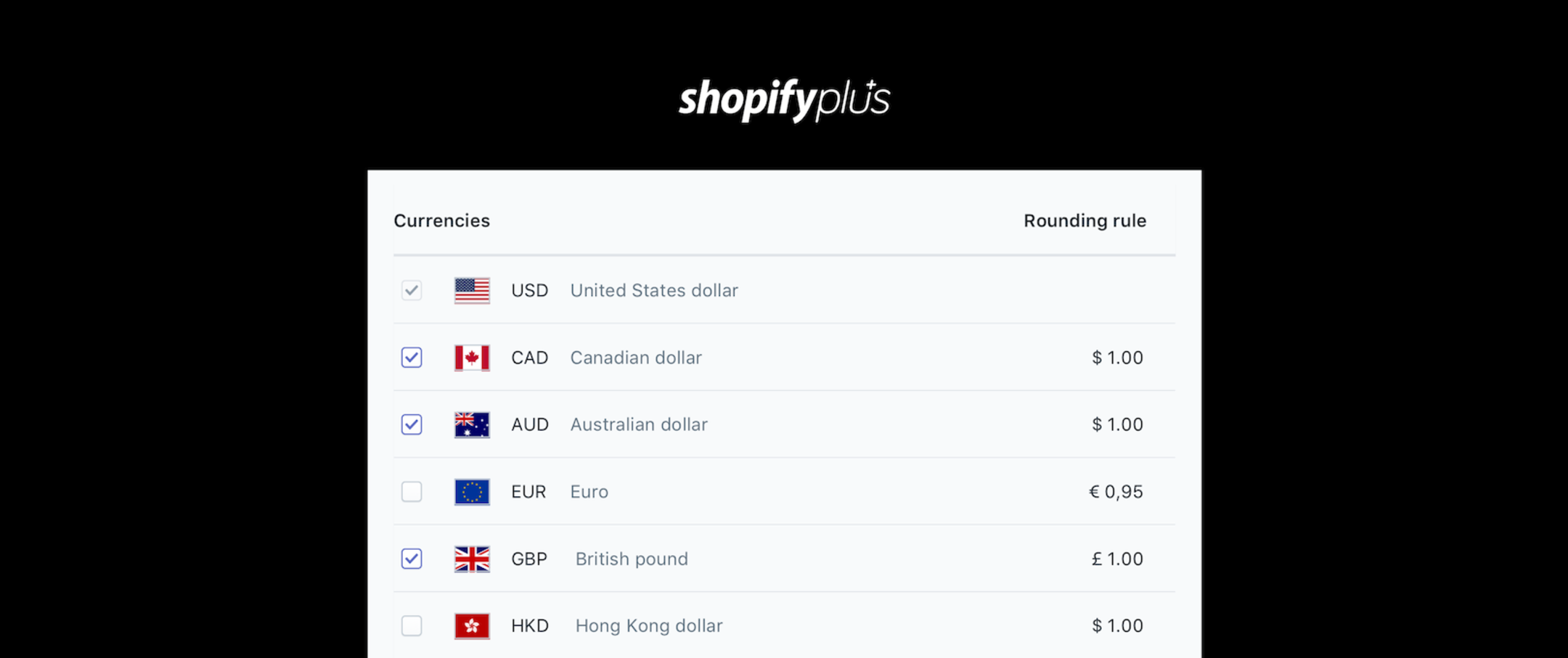Dollars, euros, pounds, or yen …
Regardless of the name, today’s consumer expects to be able to shop seamlessly in their local currency. But selling in multiple currencies can be painful.
In fact, the complexity is significant: sourcing product in one currency and selling it in another exposes your brand to technical challenges, operational hurdles — like researching what markets to enter — and foreign exchange risks that can erode margins.
Worse, the time and resources you waste with an incomplete multi-currency solution distracts you from what’s really important to scale globally:
- Customizing your marketing
- Experimenting with new channels
- Offering new products to new markets
Below, we’ll walk through why and how (or, you can read theHelp Center’s Multi-currency documentation). But if you’re already on Shopify Plus and want to start selling in multiple currencies with Shopify Payments …
Not on Shopify Plus?We’d love to talk about how we can help you expand internationally
Sell Everywhere Your Customers Live, Natively
Offering customers a robust multi-currency purchase experience is not a luxury, but a necessity. This reality becomes starkly clearwhen you consider:
- 92% of shoppers prefer to make purchases on sites that price in their local currency
- 33% are likely to abandon a purchase if pricing is in U.S. dollars only
If you want to grow globally you must act locally. The right solution allows you to sell in local currencies and settle in your own and grow while keeping your business lean.
In addition to managing it all on one store, Shopify Payments positions brands to offer customer-friendly international storefronts and checkout experiences that will perform better in three ways …
1. Simplified Growth
It’s now easier and faster than ever to expand your reach and develop a global-first mindset with Shopify Payments. Importantly, multi-currency offers the flexibility you need to make decisions —and quickly change them— on a per-currency basis and as the dynamics of specific international markets change.
You can enter new, international markets in minutes with Shopify Payments and select only the currencies in which you wish to sell. Change your mind or see a new opportunity? No problem. Shopify Payments’ multi-currency solution allows you to easily add or remove currencies based on market changes.
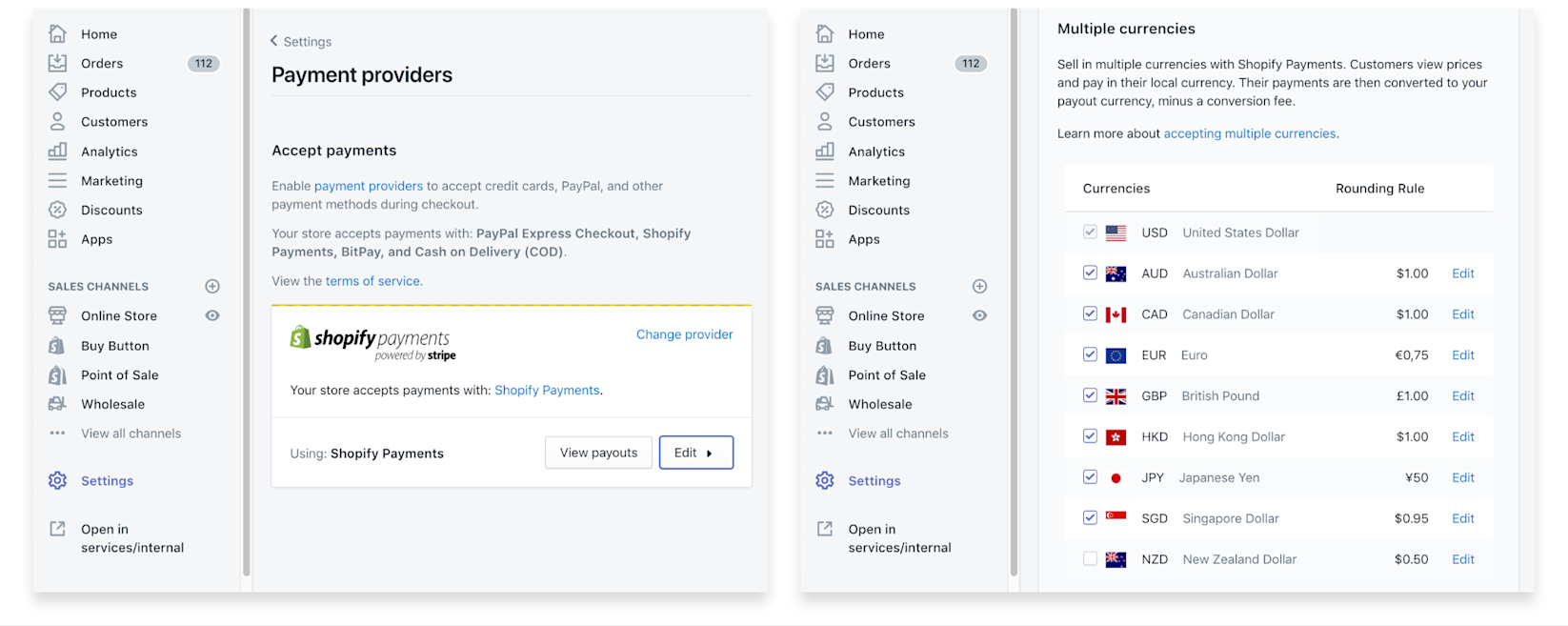
Visit our Help Center to learn how toenable multi-currency as a business on Shopify Plus
“In the first 45 days of 2019,” says Julien Plouffe — CEO atMoonglow Jewelry, “we’ve already shipped to 84 countries. This same time last year, we had only shipped to 20 countries. International visitors just weren’t converting once they reached the cart page. Allowing buyers to see our products in their local currency now gives them the confidence to finish their checkout instead of dropping out. In fact, our conversion rates in four specific countries have skyrocketed:
- Germany: 428% increase
- Saudi Arabia: 397% increase
- United Kingdom: 581% increase
- United Arab Emirates: 124% increase
“Shopify Payments’ Multi-Currency is helping us crack the code for international expansion.”

Onsite and during checkout, the right currency is a small touch that produces big results
2. Localized Experiences
When in Rome act like a Roman, right? Now you can offer customers across the world a more personalized experience regardless of where your brand is headquartered. With powerful built-in geolocation functionality, you can show customers local currency prices based on current foreign exchange rates that are rounded for stability.
Here’s how it works:
- Shopify Payments’ multi-currency feature automatically shows prices based on current foreign exchange rates
- Prices displayed to customers are generated by using your store’s price and multiplying it by the foreign exchange rate and fee, then applying the rounding rules for that currency
- This means you’ll receive a similar payout from a multi-currency order than a store currency order, and will keep your prices stable for longer
Currency conversion ensures that after rates and fees, you will still earn about the same for your multi-currency orders as your store currency orders
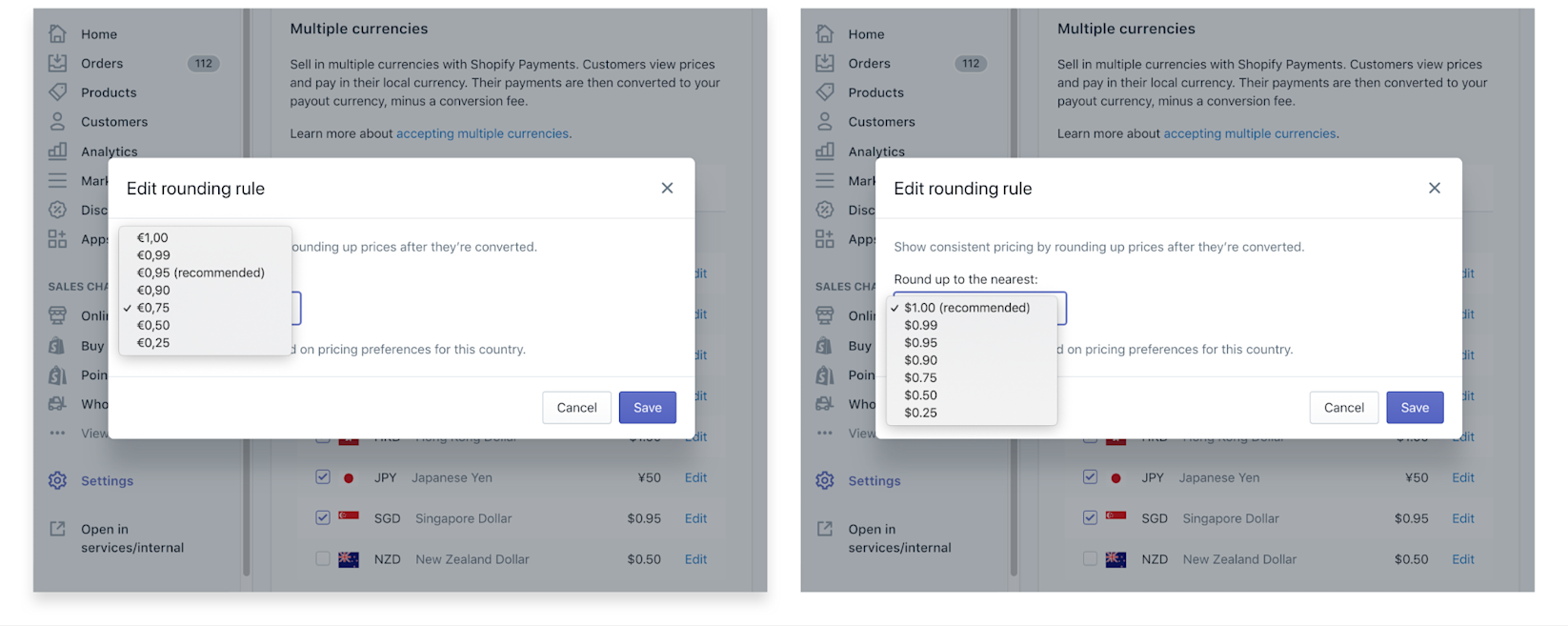
How to edit rounding rules for individual currencies: euros (left) and AUD (right)

On the frontend, rounding means customers shop in their preferred currency in the most natural, attractive way possible
Besides positioning your brand to boost conversion rates by giving customers the control they want, Shopify Payments offers you low conversion fees and no transaction fees to help you remain competitive on price.
Ediz Ozturk, founder of international fitness and apparel brandDoyoueven, admits that one of the challenges the company has identified with scaling globally was instilling customer trust.
Before using Shopify Payments’ multi-currency, Doyoueven only surfaced multiple currencies on storefront, but did not allow customers to checkout in their local currency. Ozturk notes that, without multi-currency on checkout, the experience had an “inverse effect on the relationship we had worked so hard to build between us and our audience.” His customer support team was inundated with customer calls asking for clarification, which strained greatly Doyoueven’s internal resources.
Soon after using multi-currency, the customer calls stopped and the business saw unprecedented growth. “In just the first month of implementing multi-currency, we experienced year-on-year growth of 89%, with a total sales increase of 122%,” Ozturk says. “Carrying on with a record-breaking month was a further 28% increase in orders, translating to a 39% increase in sales in the next month, which was March — a historically quieter period for the brand.”
The future is looking even brighter for Doyoueven. With confidence in the platform, the company can now focus less on technology and more on creating a seamless delivery system by expanding into fulfillment centers in the U.S. and Europe to better match its global demand.
3. Integrated Solution
It’s easier to scale internationally now that you have an integrated solution that does the heavy lifting across your storefront, checkout, orders, products, reports, apps, and more.
From product creation to payout reconciliation, Shopify’s multi-currency checkout provides a consistent experience so you can keep selling internationally with confidence.
Currency conversion is applied to …
- Product prices
- Taxes
- Gift cards
- Discounts
- Shipping
- And refunds
Businesses can also automate custom, international experiences with Shopify Scripts for automated discounting and Shopify Flow for back-end workflows.
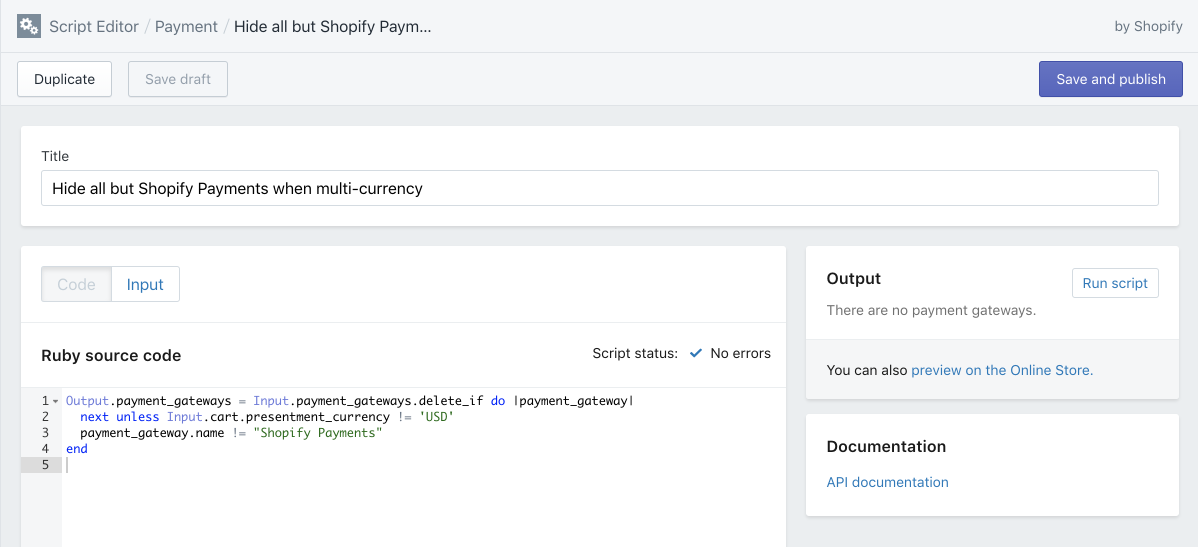
Above, Shopify Scripts lets you hide or show specific payment options; below, Shopify Flow can automatically tag international orders for easy identification or customer segmentation for marketing
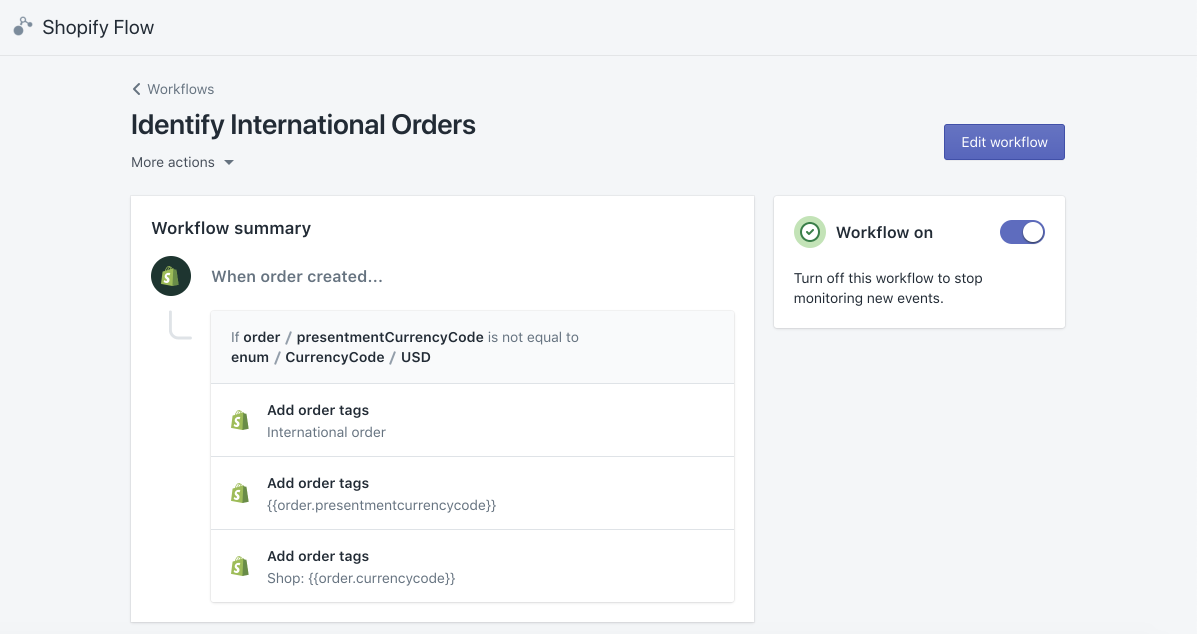
“With Shopify Payments’ multi-currency solution, it has never been easier or faster to scale globally,” according to David Cameron, a Shopify Plus product manager. “Not only can brands now sell confidently all over the world but they can do so knowing they’re providing the type of customer experience today’s consumer demands.”
Easier, Simpler, and More Lucrative
Global expansion has its complexities. But for online businesses with the right tools, tapping what analysts estimate will be a$4.5 trillionglobal B2C ecommerce market by 2021 is far less difficult than it once was.
And we promise to do even more to help you grow globally tomorrow.
Multi Currency Ecommerce FAQ
What is a multi currency?
Multi currency in ecommerce is when a merchant is able to facilitate buying and selling internationally, between currencies. Typically a software within an ecommerce platfrom will enable this.
What are the benefits of offering multi currency?
Multi currency has many benefits, such as:
- 快乐的国际米兰national shoppers
- Improved conversion rates
- Greater control over international pricing
- Customizations for different markets
Does Shopify Plus support multi currency?
Yes, Shopify plus supports stores that want to offer multi currency.
Read More
- Introducing the Shopify Plus Blog
- Wholesale Ecommerce: What is It and How to Start?
- How to Choose An Enterprise Ecommerce Platform
- Omnichannelvs Multichannel: What is the Difference and Why Does It Matter?
- What is Headless Commerce: A Complete Guide for 2022
- B2B Ecommerce: Everything You Need to Know to Get Started
- What is an Order Management System (OMS)? Your Guide to Choosing One
- Inventory Management Systems: What They Are, and Best Software for 2022
